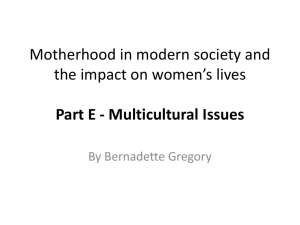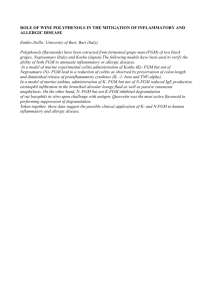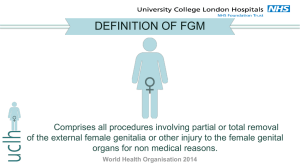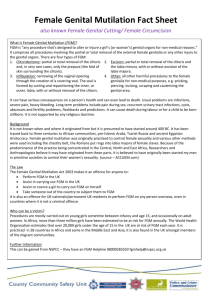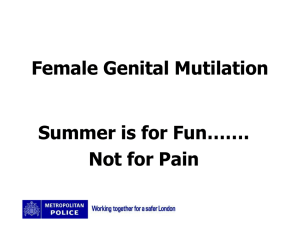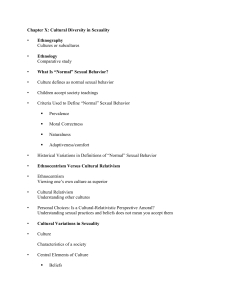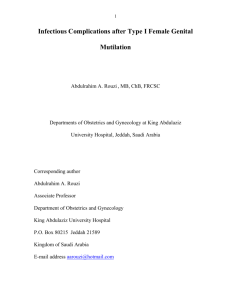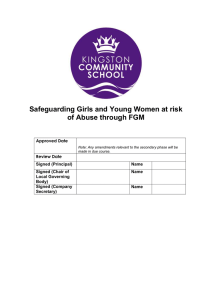World Geo wikispaces FGM citations
advertisement
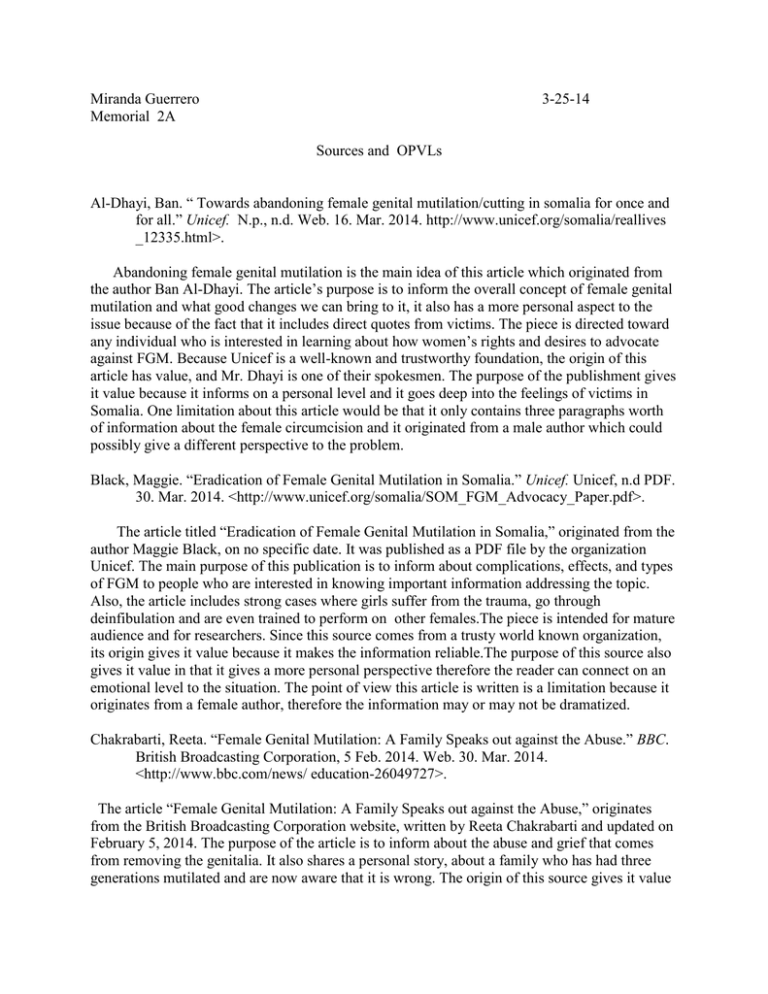
Miranda Guerrero Memorial 2A 3-25-14 Sources and OPVLs Al-Dhayi, Ban. “ Towards abandoning female genital mutilation/cutting in somalia for once and for all.” Unicef. N.p., n.d. Web. 16. Mar. 2014. http://www.unicef.org/somalia/reallives _12335.html>. Abandoning female genital mutilation is the main idea of this article which originated from the author Ban Al-Dhayi. The article’s purpose is to inform the overall concept of female genital mutilation and what good changes we can bring to it, it also has a more personal aspect to the issue because of the fact that it includes direct quotes from victims. The piece is directed toward any individual who is interested in learning about how women’s rights and desires to advocate against FGM. Because Unicef is a well-known and trustworthy foundation, the origin of this article has value, and Mr. Dhayi is one of their spokesmen. The purpose of the publishment gives it value because it informs on a personal level and it goes deep into the feelings of victims in Somalia. One limitation about this article would be that it only contains three paragraphs worth of information about the female circumcision and it originated from a male author which could possibly give a different perspective to the problem. Black, Maggie. “Eradication of Female Genital Mutilation in Somalia.” Unicef. Unicef, n.d PDF. 30. Mar. 2014. <http://www.unicef.org/somalia/SOM_FGM_Advocacy_Paper.pdf>. The article titled “Eradication of Female Genital Mutilation in Somalia,” originated from the author Maggie Black, on no specific date. It was published as a PDF file by the organization Unicef. The main purpose of this publication is to inform about complications, effects, and types of FGM to people who are interested in knowing important information addressing the topic. Also, the article includes strong cases where girls suffer from the trauma, go through deinfibulation and are even trained to perform on other females.The piece is intended for mature audience and for researchers. Since this source comes from a trusty world known organization, its origin gives it value because it makes the information reliable.The purpose of this source also gives it value in that it gives a more personal perspective therefore the reader can connect on an emotional level to the situation. The point of view this article is written is a limitation because it originates from a female author, therefore the information may or may not be dramatized. Chakrabarti, Reeta. “Female Genital Mutilation: A Family Speaks out against the Abuse.” BBC. British Broadcasting Corporation, 5 Feb. 2014. Web. 30. Mar. 2014. <http://www.bbc.com/news/ education-26049727>. The article “Female Genital Mutilation: A Family Speaks out against the Abuse,” originates from the British Broadcasting Corporation website, written by Reeta Chakrabarti and updated on February 5, 2014. The purpose of the article is to inform about the abuse and grief that comes from removing the genitalia. It also shares a personal story, about a family who has had three generations mutilated and are now aware that it is wrong. The origin of this source gives it value because it has an author and it has been recently updated. The purpose of this source gives it value because it gives a family’s point of view on the subject and it also gives factual information. A limitation of this source would be that the author is a female, so there is a lack of perspective on the subject. “Female Genital Mutilation and other Harmful Practices.” World Health Organization. World Health Organization, n.d. Web. 28. Mar. 2014. <http://www.who.int/reproductivehealth/topics/ fgm/prevalence/en/>. “Female Genital Mutilation and other Harmful Practices,” is an article which originated from the World Health Organization website. The article mainly describes increments of female cutting in African countries and shows statistics of females who have been subjects or are in risk of circumcision. Its purpose is mainly to inform and release factual information addressing the rates of FGM. The article was also written to indicate areas where female cutting is spreading and harming outrageous numbers of females. The source is valuable because it includes parenthetical citations, which help to search for where the information came from. The origin of the source gives it value in that it comes from a known organization and it is written with information from reliable sources. The purpose of the source gives it value in that the data/statistics released will help further research on the matter and it is intended for researches and advocates against FGM. A limitation this source contains is that it only focuses on the mathematical side of the issue and not on the emotional impact it has had with women, therefore the purpose limits the source slightly. The origin gives limitation to the source because the author and the date published are unknown therefore the facts are somewhat questionable and the recentness as well. “Female Genital Cutting Fact Sheet.” Womenshealth.gov. Office on Women’s Rights, 16 Jul. 2012. Web. 16. Mar. 2014. <http://www.womenshealth.gov/publications/ourpublications/ fact-sheet/female-genital-cutting.html>. This source originated July 16, 2012 and was published by the Women’s Health Department. Keeping in mind that the main topic is female genital mutilation, the website expanded on the idea and published frequently asked questions, and it also serves as a “fact sheet” for researches. The obvious purpose of this source is to inform users of an issue that threatens women’s rights and to let the audience of ways they can learn about FGM and how the world is contributing to the stop it. Since this source gives a lot of data concerning female circumcision, answers most questions, and contains links to additional sources, it’s purpose gives it more information than the origin. The origin of this source gives it value because the Women’s Health Department is a governmental organization, so the information published is most likely accurate. The origin of this website somewhat limits it’s information because it has not been updated in about two years and therefore changes may have occurred regarding FGM. The author of these paragraphs is unknown and therefore the perspective it is told in results in another limitation because it may exclude important factors that another point of view may have included. “Female Genital Mutilation (FGM).” Forward. Brainbox, n.d. Web. 16. Mar. 2014. <http://www.forwarduk.org.uk/key-issues/fgm>. This source did not have a definite author, but it originated from the campaign “FORWARD” . The purpose of this article was to inform about the reasons, consequences, and types/procedures of female circumcision, and it is intended for mature researches who want to learn about events that affect women’s rights on a worldwide level. The information was also published because people such as social workers are concerned about the damages this procedure can bring upon the female sex. The Forward source is useful because its origin focuses on women’s rights and sexual practices. The purpose of the source gives it value because it is important to inform internet users about immoral events that happen in our modern world. One of the limitations this source contains because of its origin is that it has no date of publishment and no official author that uploaded it. And since the author is unknown, then the point of view this was written in is unknown as well, therefore the source could be told from a limited point of view. “Female Genital Mutilation.” NHS Choices. Gov.Uk, 26. Jun. 2012. Web. 16. Mar. 2014. <http://www.nhs.uk/conditions/female-genital-mutilation/Pages/Introduction.aspx>. The information published on NHS Choices focuses on explaining forms and effects of FGM, it originated June 26th 2012. Millions of people are not aware of what FGM is or where and to whom it occurs, and webpages like these which contain articles that release information about issues that violate women's rights are created to inform and persuade people to act against FGM. Publications about FGM are intended for researches, health professionals, and people who work for equality, since most contain explicit material, they are also intended for a mature audience. The origin of this source gives it value in that it is reliable and it has links to governmental views on FGM. The purpose also gives NHS Choices value because it helps understand the magnitude of FGM and it suggests ways to stop it. Since this article gives no credit to a specific author, it is questionable because the information given is not cited. Another limitation to this source would be the date that it was published; it has been almost two years since this information was released and problems concerning female circumcision may have changed during that time. Moges, Ashenafi. “What is behind the tradition of FGM?” African Women.org. African Women.org, n.d. PDF. 1 Apr. 2014 <http://www.african-women.org/documents/behind FGM-tradition.pdf>. The article originates from the African Women website, written by Ashenafi Moges, and uploaded as a PDF file. The source focuses on two main, broad questions concerning FGM and how it is viewed by society. The purpose of this source is to inform about female circumcision and give the reader factual information of how practices like these are extremely harmful, and yet little is done to control them. The article is intended for people who advocate for equality, researchers, professors, students and even other NGO’s who are contributing to a world without FGM. The origin of the source gives it value because it comes from an organization that focuses on African women’s rights and creating awareness, the website was made by African women from somalia, ethiopia, etc. which are places where FGM is most commonly practiced. The purpose of the source gives it value because it is informing the audience about all the wrong factors of FGM, the consequences of it, and the hardship it puts more than 98% of women through. The perspective the article is written in is a limitation to the value because it does not contain information that another point of view could offer. Also, the date of publishment or actualization is unknown, this is another limitation because we don’t know how recent the data is, and facts about FGM could have changed over a period of time. Reymond, Laura et al. “Female Genital Mutilation- The Facts.” Path.org. N.p., n.d. Web. 31 Mar. 2014. <http://www.path.org/files/FGM-The-Facts.htm>. The article originates from Path.org and was written by a variety of authors such as Laura Reymond and Asha Mohamud. The purpose of the article is to inform about when, where, why and how female circumcision is performed. The intended audience are researchers, social workers, and students. The piece is intended for a mature audience because of its explicit content, and it is also intended for other organizations who are working for equality in women’s rights. The origin of the source gives it value because it was writ by authors who have cited their work and have included the citations/references at the end of the article for further reading. Because the source contains so much information, its purpose gives it value since it includes subsections concerning FGM and various statistics of different countries in Africa. A limitation this source contains that comes from its origin is the fact that it has no victim interviews or emotional appeal to the matter. Another limitation that comes from the origin is the women perspective it was written in.
